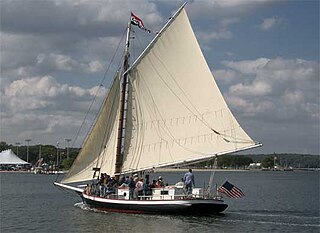
Mystic Seaport Museum or Mystic Seaport: The Museum of America and the Sea in Mystic, Connecticut is the largest maritime museum in the United States. It is notable for its collection of sailing ships and boats and for the re-creation of the crafts and fabric of an entire 19th-century seafaring village. It consists of more than 60 historic buildings, most of them rare commercial structures moved to the 19-acre (0.077 km2) site and meticulously restored.

C.A. Thayer is a schooner built in 1895 near Eureka, California. The schooner has been preserved and open to the public at the San Francisco Maritime National Historical Park since 1963. She is one of the last survivors of the sailing schooners in the West coast lumber trade to San Francisco from Washington, Oregon, and Northern California. She was designated a National Historic Landmark on 13 November 1966.

Alma is an 1891-built scow schooner, which is now preserved as a National Historic Landmark at the San Francisco Maritime National Historical Park in San Francisco, California.

Effie M. Morrissey is a schooner skippered by Robert Bartlett that made many scientific expeditions to the Arctic, sponsored by American museums, the Explorers Club and the National Geographic Society. She also helped survey the Arctic for the United States Government during World War II. She is currently designated by the United States Department of the Interior as a National Historic Landmark as part of the New Bedford Whaling National Historical Park. She is the State Ship of Massachusetts.

The skipjack is a traditional fishing boat used on the Chesapeake Bay for oyster dredging. It is a sailboat which succeeded the bugeye as the chief oystering boat on the bay, and it remains in service due to laws restricting the use of powerboats in the Maryland state oyster fishery.

The schooner J. & E. Riggin, a National Historic Landmark, was built on the Maurice River in Dorchester, New Jersey in 1927. She is one of a small number of surviving two-masted schooners, once one of the most common sailing ships in North American waters. Now based in Rockland, Maine, she serves as a "windjammer" offering sailing cruises to tourists.
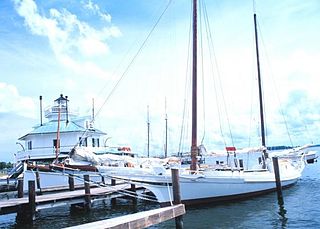
The bugeye is a type of sailboat developed in the Chesapeake Bay for oyster dredging. The predecessor of the skipjack, it was superseded by the latter as oyster harvests dropped.

Modesty was an oyster sloop built in 1923 by The Wood and Chute Shipyard of Greenport, Long Island, and is now located at the Long Island Maritime Museum in West Sayville, New York.
Priscilla as the name of a ship may refer to:

Emma C. Berry is a fishing sloop located at the Mystic Seaport Museum in Mystic, Connecticut, United States, and one of the oldest surviving commercial vessels in America. She is the last known surviving American well smack. This type of boat is also termed a sloop smack or Noank smack. The Noank design was imitated in other regions of the United States.
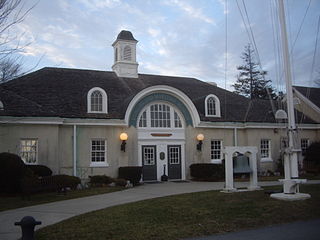
The Long Island Maritime Museum is located in West Sayville, New York.

The Edna E. Lockwood is a Chesapeake Bay bugeye, the last working oyster boat of her kind. She is located at the Chesapeake Bay Maritime Museum in Saint Michaels, Maryland. She was built in 1889 at Tilghman Island, Maryland by John B. Harrison and is of nine-log construction, similar to the smaller log canoe, and was launched on October 5, 1889 for Daniel Haddaway, at a cost of $2,200. She worked for at least seven sets of owners from 1899 until 1967, and was then sailed as a yacht until donated to the museum in 1973. The museum undertook an extensive restoration of the Lockwood from 1975 through 1979, which restored the bugeye to its 1910 appearance with the "patent stern" that had been added sometime prior to that year. She is the last bugeye retaining the sailing rig and working appearance of the type. Her length is 53.5 feet (16.3 m), with a 15.25 feet (4.65 m) beam and a draft of 2.58 feet (0.79 m) with the centerboard up, and a maximum sail area of approximately 1700 square feet.

The Rebecca T. Ruark is a Chesapeake Bay skipjack built at Taylor's Island, Maryland. She is homeported at Tilghman Island, Maryland. Built in 1896, she is the oldest surviving skipjack in the Chesapeake Bay fleet. She was designated a National Historic Landmark in 2003.

The William B. Tennison is a Chesapeake Bay bugeye built in 1899 and converted to an oyster buy-boat in 1906–07. With the conversion her sail rig was removed and an engine inserted, and is the only surviving example of this conversion. Her construction marks a transition between log construction and plank construction. She is homeported at the Calvert Marine Museum in Solomons, Maryland. The Tennison is reputed to be the second oldest licensed passenger vessel in the United States.
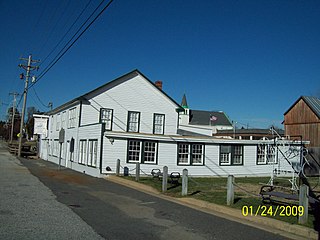
J. C. Lore Oyster House, also known as J. C. Lore and Sons, Inc., Seafood Packing Plant, is located at 14430 Solomons Island Road South, in Solomons, Calvert County, Maryland. It is a large two story, rectangular frame industrial building constructed in 1934 as a seafood packing plant. It replaced a 1922 building that was destroyed by the 1933 Chesapeake Potomac hurricane. It is significant for its historical association with the commercial fisheries of Maryland's Patuxent River region, and architecturally as a substantially unaltered example of an early-20th century seafood packing plant. It has been adapted by the Calvert Marine Museum to house exhibits and many of its original spaces, artifacts, and records have been incorporated into them.

The Nellie Crockett is a Chesapeake Bay oyster buy-boat built for Andrew A. Crockett of Tangier, Virginia, in 1925. She is located at Georgetown, Maryland, USA. She was designated a National Historic Landmark in 1994.
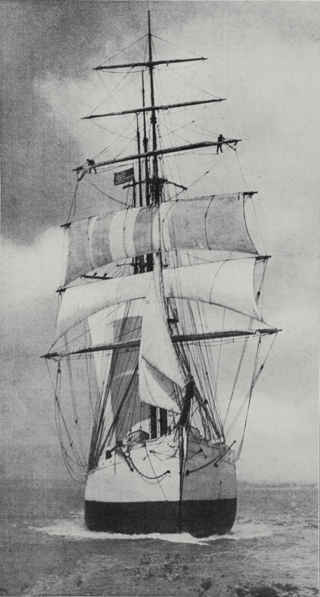
Amaranth was a four-masted barquentine built by Matthew Turner of Benicia, California in 1901. Amaranth sailed in the China trade between Puget Sound and Shanghai. She was wrecked on a guano island in the South Pacific in 1913 while carrying a load of coal.

Hope is an oyster sloop that was completed in 1948. It is believed to be the last sail-powered oystering vessel built on the Long Island Sound. Hope is 56 feet (17 m) long, including the bowsprit, and 42 feet 2 inches (12.9 m) at the waterline. Its beam is 15 feet 2 inches (4.6 m), and it draws 4 feet 9 inches (1.4 m) with the centerboard up. Hope is gaff rigged, 'V'-bottomed and has an 850-pound (390 kg) centerboard. Hope's shallow draft facilitated shoal water work.








